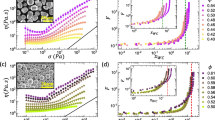Abstract
The effects of a recombinant small heat shock protein with an apparent molecular weight of 27 kDa (Hsp27) and both wild type (Hsp27-wt) and S15D, S78D, S82D mutants (Hsp27-3D), which mimic the naturally occurring phosphorylation of this protein, on the thermal denaturation and aggregation of F-actin were studied. It has been shown that at a Hsp27/actin weight ration of 1/4, both Hsp27-wt and Hsp27-3D do not affect the thermal denaturation of F-actin, but efficiently prevent its further aggregation by forming soluble complexes with denatured actin. Formation of these complexes occurs upon heating and accompanies the F-actin thermal denaturation. Hsp27-wt is known to exist as a high-molecular-weight oligomer, whereas Hsp27-3D forms only small dimers or tetramers. However, the complexes formed by Hsp27-wt and Hsp27-3D with denatured actin did not differ in their size, as measured by dynamic light scattering, and demonstrated the same hydrodynamic radius of 17–18 nm. On the other hand, the sedimentation coefficients of these complexes differed: they ranged 10–45 S in the case of Hsp27-3D and 18–60 S in case of Hsp27-wt. Thus, the initial oligomeric state of Hsp27 does not significantly affect its capacity to form small soluble complexes with denatured actin.
Similar content being viewed by others
Abbreviations
- DLS:
-
dynamic light scattering
- sHSP:
-
small heat shock proteins
- Hsp27:
-
a small heat shock protein with an apparent molecular weight of 27 kDa
- Hsp27-wt:
-
recombinant Hsp27 of wild type
- Hsp27-3D:
-
Hsp27 with mutations S15D, S78D, and S82D, which mimic its phosphorylation
References
V. V. Mikhailova, B. I. Kurganov, A. V. Pivovarova, and D. I. Levitsky, Biokhimiya 71(11), 1550 (2006) [Biochemistry (Moscow) 71 (11), 1261 (2006)].
A. V. Pivovarova, V. V. Mikhailova, I. S. Chernik, et al., Biochem. Biophys. Res. Commun. 331, 1548 (2005).
N. B. Gusev, N. V. Bogacheva, and S. B. Marston, Biokhimiya 67(5), 613 (2002) [Biochemistry (Moscow) 67 (5), 511 (2002)].
M. Halsbeck, Cell Mol. Life Sci. 59, 1649 (2002).
U. Jakob, M. Gaestel, K. Engel, and J. Buchner, J. Biol. Chem. 268, 1517 (1993).
R. Shashidharamurthy, H. A. Koteiche, J. Dong, and H. S. McHaourab, J. Biol. Chem. 280, 5281 (2005).
B. Lelj-Garolla and A. G. Mauk, J. Biol. Chem. 281, 8169 (2009).
J. Huot, F. Houle, D. R. Spitz, and J. Landry, Cancer Res. 56, 273 (1996).
A. L. Bryantsev, S. A. Loktionova, and O. P. Ilyinskaya, Cell Stress Chaperones 7, 146 (2002).
B. N. Singh, K. S. Rao, T. Ramakrishna, et al., J. Mol. Biol. 366, 756 (2007).
T. Rogalla, M. Ehmsperger, X. Preville, et al., J. Biol. Chem. 274, 18947 (1999).
B. Lelj-Garolla and A. G. Mauk, J. Mol. Biol. 345, 631 (2005).
A. V. Pivovarova, N. A. Chebotareva, I. S. Chernik, et al., FEBS J. 274, 5937 (2007).
J. A. Spudich and S. Watt, J. Biol. Chem. 246, 4866 (1971).
O. O. Panasenko, M. V. Kim, S. V. Marston, and N. B. Gusev, Eur. J. Biochem. 270, 892 (2003).
P. Schuk, Biophys. J. 78, 1606 (2000).
J. S. Philo, AAPS J. 8, E564 (2006).
T. Stromer, M. Ehmsperger, M. Gaestel, and J. Buchner, J. Biol. Chem. 278, 18015 (2003).
Author information
Authors and Affiliations
Additional information
Original Russian Text © A.V. Pivovarova, N.A. Chebotareva, N.B. Gusev, D.I. Levitsky, 2008, published in Biofizika, 2008, Vol. 53, No. 5, pp. 766–771.
Rights and permissions
About this article
Cite this article
Pivovarova, A.V., Chebotareva, N.A., Gusev, N.B. et al. Some properties of complexes formed by small heat shock proteins with denaturated actin. BIOPHYSICS 53, 361–365 (2008). https://doi.org/10.1134/S0006350908050072
Received:
Published:
Issue Date:
DOI: https://doi.org/10.1134/S0006350908050072




